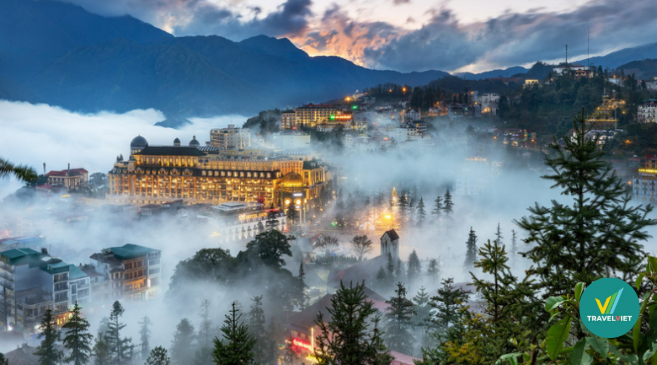General introduction of Lao Cai
Lao Cai is a prominent destination in the Northwest region of Vietnam - a place where the majestic beauty of Sa Pa converges with the vibrant golden hues of Mu Cang Chai. It is a melting pot of culture, nature, and ethnic identity, opening a new chapter of development with vast potential in ecotourism, border-gate economy, and sustainable agriculture.
Lao Cai borders the provinces of Tuyen Quang, Phu Tho, Son La, and Lai Chau, and shares a border with China, creating a special advantage for international trade, tourism, and highland economic development. Lao Cai is located approximately 160 km from Hanoi and has a border stretching over 180 km with Yunnan province, China. The province comprises 99 commune-level administrative units, including 10 wards and 89 communes, with its administrative center situated in Lao Cai City.

Province location Lao Cai on Vietnam map
Prominent destinations in Lao Cai
Lao Cai is currently a destination that embodies the essence of the Northwest region, where History and Culture (Lao Cai City, ethnic villages) blend with the majestic Geological and Ecological wonders (Fansipan, Sa Pa terraced rice fields). This manual will guide you through a vibrant Lào Cai, from unique local cultural spaces to the magnificent natural landscapes on the "Roof of Indochina."
Sa Pa: The Misty Haven That Captivates Thousands
Sa Pa is always the first destination that comes to mind when speaking of the Northwest. Located suspended high above the ground, it is year-round enveloped by wisps of drifting mist and fog. Situated at an elevation of approximately 1,600m, Sa Pa is considered the iconic image of Northwest tourism, where a cool, temperate climate converges with diverse ethnic cultures. Sa Pa not only boasts a cool climate similar to Da Lat but also features magnificent man-made wonders crafted by the local ethnic communities. You must visit Muong Hoa Valley and villages like Cat Cat and Ta Van to witness the stunning terraced rice fields firsthand, especially during the golden harvest season (September - November). Furthermore, conquering Ham Rong Mountain to take in the entire town view, or checking in at the ancient Stone Church, are unmissable experiences. Sa Pa is beautiful year-round, but if you are lucky during winter, you might even get the chance to "hunt" for snow and ice!
Foggy town Sapa
Fansipan Peak: Touching the Roof of Indochina
Fansipan (3,143m) is the pride and the "Roof of Indochina," the highest mountain in Vietnam, standing majestically amidst the magnificent Hoang Lien Son range. With the assistance of the modern cable car system, the peak is no longer an overly difficult challenge, but has become a sacred destination that every visitor to Sa Pa wishes to behold. At the summit of Fansipan, next to the legendary marker, lies a massive and majestic spiritual architectural complex, floating amidst a sea of white, billowing clouds.
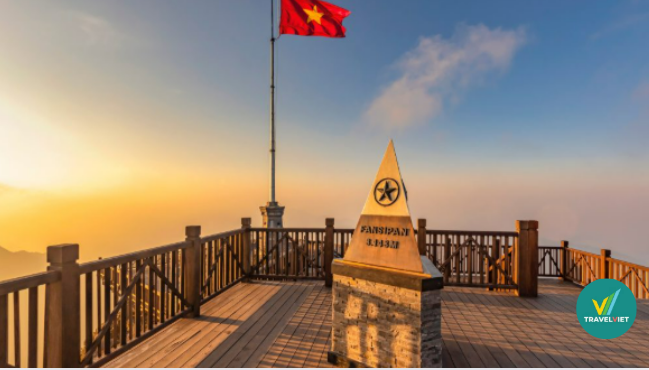
Fansipan peak area
Y Ty – Bát Xát: The Land of Clouds and Mystery
Y Ty is a highland commune located deep within the Bat Xat district, famous for the designation, "the misty land." The area is covered in clouds nearly year-round, forming sprawling, white, floating "seas of clouds" right below your feet, making it an especially ideal sight to behold from Lao Than Peak. Y Ty possesses a wild, pristine beauty and features a unique architectural style: the mushroom-shaped Trinh Tuong houses of the Ha Nhi people, which appear and disappear in the mist and clouds, creating an extremely mysterious and fascinating atmosphere. Situated at an altitude of over 2,000m above sea level, this is home to the Ha Nhi ethnic group. The journey to Y Ty is challenging, with difficult, winding roads and curving mountain passes. But once you set foot here, you will be completely immersed in the majestic nature and the unique cultural identity.
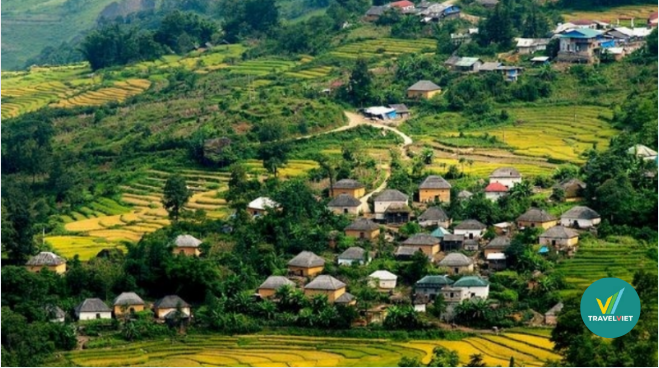
Houses reported in Y Ty
Mu Cang Chai: The Land of Endless Golden Harvest
Mu Cang Chai is perhaps a name that is no longer unfamiliar to tourists seeking pristine nature and the peaceful atmosphere of the Northwest highlands. Annually, around September, Mu Cang Chai begins its ripe rice season, which is arguably the most ideal travel time that you cannot miss. The sight of the terraced rice fields, glowing a brilliant gold, seems to ignite the vitality of the entire region. Witnessing this breathtaking landscape will undoubtedly leave you in awe and full of praise.
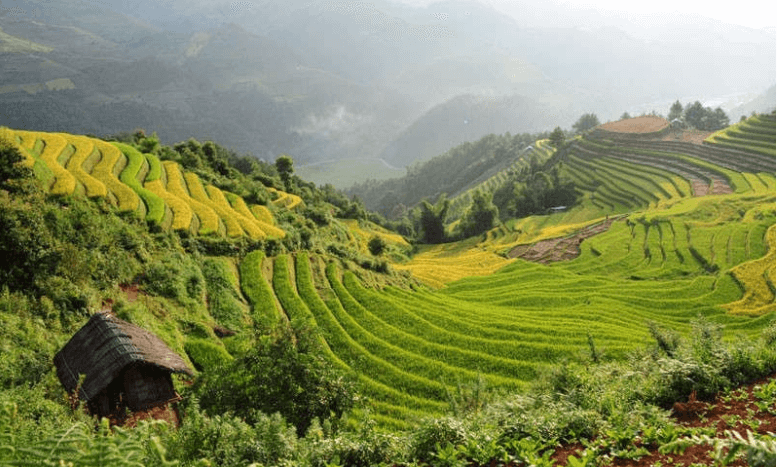
Mu Cang Chai terraced fields.
In addition to the prominent Lao Cai tourist spots mentioned above, here are other locations travelers can explore:
- Ta Xa – Tram Tau: The Challenge of Cloud Hunting: Ta Xua is known as the "cloud hunting paradise" of Vietnam, where ribbons of clouds cascade over the mountain slopes, creating a magical scene. The route to conquer Ta Xua Peak offers a fascinating, adventurous experience for exploration lovers. Nearby, Tram Tau is famous for its natural hot springs, where visitors can relax after a mountain trek. The combination of majestic nature and unique ethnic culture makes this an unforgettable stop.
- Mu Cang Chai Terraced Fields: Ha Long Bay in the Mountains: Thac Ba Lake is one of the three largest artificial lakes in Vietnam, likened to "Ha Long on the mountains" with over 1,300 large and small islands. The peaceful scenery and the emerald-green surface of the lake amidst the mountains and forests create an ideal space for activities like cruising, fishing, exploring Thac Ba cave, or visiting the sacred Thac Ong and Thac Ba temples. This location is suitable for ecotourism, relaxation, and experiencing the highland river life.
- Bac Ha Weekend Market: Known as one of the largest and most unique weekend markets in the Northwest region, it is a place for cultural exchange and trade among various ethnic minorities, such as the H'mong, Dao, Tay, and Nung.
- O Quy Ho Pass: One of Vietnam's "Four Great Mountain Passes," famous for its magnificent scenery, it forms the natural boundary between Lao Cai and Lai Chau. It is also an ideal spot to watch the sunset and hunt for clouds, often referred to as Heaven's Gate.
- Muong Hoa Valley & Sa Pa Ancient Rock Field: Home to many ethnic villages (such as Ta Van, Lao Chai) and a national relic site featuring ancient carved rocks, possessing unique historical and cultural value.
- Pu Nhu Waterfall (Mu Cang Chai): A majestic waterfall with white, frothing water cascading through the pristine mountains and forests, not far from the center of Mu Cang Chai district.
- Tu Le Valley (Van Chan District): Located at the foot of Khau Pha Pass, famous for the beauty of its rice fields and the traditional "Tam Tien" (Fairy Bathing) culture of the Thai people.
Outstanding historical relics in Lao Cai
Bao Ha Ong Hoang Bay Temple – The Sanctuary of the "Guardian Deity"
The most commonly told legend about Ong Hoang Bay is as follows: Throughout Vietnam's feudal history, Bao Ha held a crucial position for border defense, acting as a frontier post along the Red River defensive line in the Northwest. Since the Tran Dynasty, two key checkpoints were established: Bao Thang and Bao Ha, with Bảo Hà serving as the rear base for Bao Thang. This location housed a signal fire station and a communication post for the lower districts and prefectures.
In the mid-Canh Hung reign, Bao Ha was the center of Chau Van Ban. During the Canh Hung period (1740–1786), northern invaders frequently crossed the border to harass and plunder. Khau Ban commune in Chau Van Ban had to build ramparts and fortresses to defend against the enemy. Faced with this heartbreaking scene of suffering, coupled with the threat of invasion, General Nguyen Hoang Bay was entrusted by the royal court with the critical responsibility of raising an army to quell the chaos in the border region.
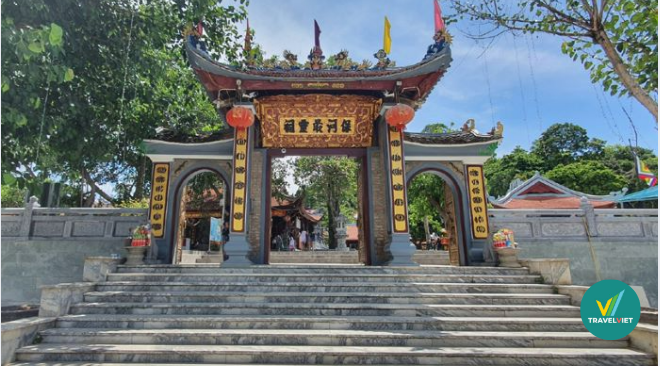
Bao Ha Temple - Temple to worship the famous general Hoang Seven.
Historical Relic: Nghia Lo Camp and Post
The historical relic of the Nghia Lo Camp and Post was recognized as a National Historical Site on September 27, 1996. Located about 80km from Yen Bai Ward via National Highway 32, you will reach the Muong Lo field in Nghia Lo Commune. Upon arriving at the western town of Nghia Lo, you can visit the historical site of the Camp and Post, Uncle Ho's stilt house, and learn about the unique culture of the Thai ethnic people.
The Nghia Lo Camp and Post historical site was the location of glorious battles and the victorious liberation of Nghia Lo town in 1952. A highlight of this Lao Cai tourist spot is that it is situated right on the main axis of the Dien Bien road, lying within the basin of the Muong Lo field.

Nghia Lo victory monument at Nghia Lo Cang and Fort relic site
Travelers interested in history and people can explore five additional famous historical sites in Lao Cai, including:
- Den Thuong (Upper Temple): Dedicated to the National Hero, Hung Dao Dai Vuong (Grand Prince Hung Dao) Tran Quoc Tuan, National Duke of Command, this is a national-level historical-cultural relic situated at a strategic border location.
- Hoang A Tuong Mansion: A national-level historical architectural work featuring a unique Asian-European style. It was once the residence of the father and son, "King of the H'mong" Hoang Yen Chao and Hoang A Tuong.
- Sa Pa Ancient Rock Field Relic: A collection of mysterious ancient carved rocks, holding long-standing archaeological and historical-cultural value, recognized as a national-level relic.
- Nguyen Thai Hoc Historical Relic Site: The resting place of the revolutionary Nguyen Thai Hoc and the soldiers who sacrificed their lives during the Yen Bai Uprising (1930), embodying the spirit of patriotism and struggle.
- Dong Cuong Mother Temple (Den Mau Dong Cuong): The largest center for worshipping the Mother Goddess of the Forest in the North, and one of the important National Relics related to the Vietnamese belief in the Three Palaces Mother Goddess.
- Stadium Grandstand – Where President Ho Chi Minh Visited and Spoke to the People: The Stadium Grandstand National Historical-Cultural Relic is the site where President Ho Chi Minh visited and addressed the people of Lao Cai on September 25, 1958. Also notable are the tomb area of Nguyen Thai Học and the soldiers of the Yen Bai Uprising (February 1930), and a system of spiritual and cultural historical sites such as Tuan Quan Temple, Bach Lam Temple and Pagoda, and Ngoc Am Pagoda. Not far from the city center is the Van War Zone National Historical Site, which also features beautiful and pristine natural landscapes such as Van Hoi Lagoon and Hau Lagoon, all unmissable and attractive tourist destinations for every visitor.
Best Time to Visit
Lao Cai, with its majestic natural landscapes and diverse culture, is beautiful and appealing throughout all four seasons. To help you plan the most fulfilling trip, here are details on the ideal times to visit and the prominent experiences offered throughout the year:
Spring (March – May): The Season of Rebirth and Romance
If you are a lover of the romance of spring, come to the Northwest during this time. The weather across Lao Cai is cool and fresh. This is precisely when the entire region awakens: peach, plum, and pear blossoms burst forth in vibrant color. You can admire the white and pink hues covering the hillsides in Sa Pa and Muong Hoa Valley, or participate in the unique Pear Blossom Festival in Bac Ha. Spring is also the ideal time to hunt for clouds and savor the scent of the earth and sky in the highland villages.

Peach blossoms in the Stone Plateau region
Summer (May – June): The Pouring Water Season and Endless Green
Summer brings a sparkling beauty and renewed vitality to Lao Cai. This is the pouring water season on the terraced rice fields, especially in Mu Cang Chai. Water is channeled from streams, making the surface of the fields shimmer like gigantic mirrors, reflecting the clouds, sky, and mountain shadows, thus attracting many tourists and photographers. This is also the ideal time to explore cool areas like Thác Bà Lake or relax at the Tram Tau hot springs.

Hot spring bathing area at Tram Tau Hot Springs
Autumn (September – November): The Golden Moment and Most Splendid Time
This transitional period is considered the most beautiful time of the year for the entire region. The Northwest sky is high, clear, and dry, making it ideal for all exploration activities. Tourists flock to both provinces to admire the terraced fields during the harvest season. The sight of golden, brilliant rice waves stretches across Sa Pa, Y Ty, and most prominently in Mu Cang Chai—home to the famous Mam Xoi Hill (Raspberry Hill). The favorable weather is also a great condition for conquering Fansipan Peak without dense fog. After your rice-viewing trip, don't forget to enjoy the fragrant, chewy Com (young green rice) in Tu Le.
Winter (December – February): Ice and Snow Hunting and Unique Experiences
Winter brings deeply cold weather, creating a unique and challenging experience. The freezing climate offers you the chance to witness ice and snow - a rare phenomenon in Vietnam, often appearing on Fansipan Peak or in the Y Ty area. If you prefer to avoid the cold, you can visit Thác Bà Lake or soak in the Trạm Tấu hot springs for relaxation. Furthermore, around the New Year, the spiritual festival atmosphere at temples like Upper Temple is also very lively.

Sa Pa submerged in snow white
Lao Cai Travel Information
From Hanoi, travelers can easily reach the Northwest provinces, such as Lào Cai, using various means of transportation.
By Train from Hanoi to Lao Cai
The train route from Hanoi Station to Lào Cai Station takes approximately 3 to 8 hours (fast trains like SE or tourist trains like SP). From Lào Cai Station, it is only about 35 km to Sa Pa.
Ticket Prices (per trip):
- Hard Seat: around 180,000 – 250,000 VND
- 6-berth Sleeper: around 350,000 – 450,000 VND
- 4-berth Sleeper (High-quality tourist trains like Sapaly, King Express): 600,000 – 850,000 VND
By Train from Hanoi to Yen Bai
The train route from Hanoi Station to Yen Bai Station takes approximately 3 – 4 hours.
Ticket Prices (per trip):
- Hard Seat: 100,000 – 150,000 VND
- Soft Seat: 150,000 – 200,000 VND
- Sleeper Berth (if taking the night train): 250,000 – 350,000 VND
Coach Bus, Limousine, or Private Car
From Hanoi, there are two directions leading to the Southwest part of Lao Cai. Departing from Hanoi city center, you have two main routes to easily reach Lao Cai: National Highway 32 and National Highway 70. The routes are not overly difficult, and you can check a map beforehand to review the paths.To reach famous destinations like Van Chan Commune, Mu Cang Chai, and Nghia Lo Ward, you should follow National Highway 32. This road is quite scenic, and traveling by motorbike is a fascinating experience. To head toward Nam Cuong Ward, you can take National Highway 70 or the Hanoi – Lao Cai Expressway and exit at the Lao Cai interchange, following the directional signs. Traveling by motorbike is also favored by many young people, as it offers many unforgettable memories.
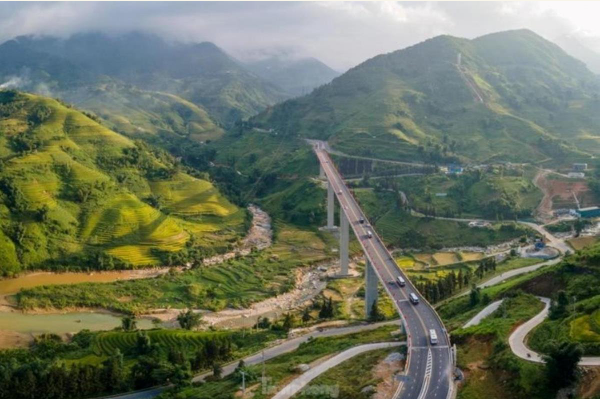
A Section of theNoi Bai - Lao Cai Expressway
Coach buses are a very familiar choice for many tourists visiting Lao Cai, with numerous trips available daily from My Dinh Bus Station in Hanoi. The service quality is generally very good, and these buses will terminate at Yen Bai Bus Station.Travelers from other provinces and cities can fly or take a train/coach bus to Hanoi, and then continue their journey to Lao Cai. For those traveling from neighboring localities, use National Highways QL70, QL12, QL4D, QL4E, or Provincial Road DT155, etc.
Below are details for some coach bus operators:
-
Limousine (Inner-city pick-up/drop-off): The Hanoi – Lao Cai route operates continuously throughout the day, departing from 5:00 AM to 8:00 PM at both ends, with a frequency of one trip every hour. Limousine services offer door-to-door pick-up and drop-off within the inner city, providing convenience and comfort for passengers. The fare is approximately 200,000 VND per trip.
-
Viet Phuong Bus Company (VIP Sleeper): Viet Phuong serves the Hanoi – Lao Cai route with high-class sleeper buses, departing from 8:00 AM to 8:15 PM in Hanoi and from 7:00 AM to 7:00 PM in Lao Cai. The buses run regularly throughout the day, suitable for travelers who prefer to move during the day or evening. The fare is consistently 200,000 VND per trip.
-
Sao Viet Bus Company (VIP Sleeper): This is one of the most famous operators on the Hanoi – Lao Cai route, running continuously almost all day, from 6:00 AM to 11:00 PM in Hanoi and from 7:00 AM to 11:30 PM in Lao Cai. There is one trip every hour, offering high flexibility for travelers' itineraries. The VIP sleeper buses are clean and comfortable, with a fare of 250,000 VND per trip.
-
Hai Phuong Bus Company: Hai Phuong operates the Hanoi – Lao Cai route with departures from My Đinh Bus Station between 9:00 AM – 4:00 PM, and the return trip from Yen Bai Bus Station between 7:15 AM – 6:15 PM. They use quality sleeper buses with attentive service, and the fare is 250,000 VND per trip, suitable for passengers traveling between the two provinces.
Getting Around in the City and Region
In Lao Cai, travelers can begin their journey from Sa Pa, taking the cable car or trekking to conquer Fansipan Peak—the "Roof of Indochina."From Sa Pa, you can rent a motorbike or car to explore Bac Ha and Y Ty, areas that fully retain their pristine nature and unique local culture. The routes through Mường Hum, A Lu, or Y Ty offer beautiful experiences amidst the clouds, sky, and vast terraced fields.
Motorbike Rental Services
Zonitrip (Yen Bai Ward)
- Rents motorbikes, supports pick-up and drop-off between Tu Le and Mu Cang Chai.
- Simple procedures: a deposit of an ID card/Citizen ID Card and approximately 1 million VND.
- Rental price: around 200,000 VND/day/bike, includes 2 helmets.
- Address: 246 Le Hong Phong, Yen Bai Ward.
Hung Nga (Mu Cang Chai)
- Specializes in motorbike rentals for trekking/touring routes, with support for pick-up and drop-off at locations like Nghia Lo and Tram Tau.
- Rental price ranges from approximately 120,000 – 180,000 VND/day, depending on the bike type.
- The shop provides manual (gear) and clutch bikes suitable for mountain roads.
Tuyen Mai (Mu Cang Chai Commune)
- Manual (Gear) bike: 100,000 – 150,000 VND/day
- Automatic (Scooter) bike: 120,000 – 180,000 VND/day
- Clutch bike (Exciter, trail bikes): 180,000 – 250,000 VND/day
Flamingo Laocai Motorbike Tours and Rentals
- Phone: 0866 680 454
- Address: 52 Phan Dinh Phung, Pho Moi, Lao Cai Ward.
- Manual (Gear) bike rental price: 100,000 VND/day
- Automatic (Scooter) bike rental price: 200,000 VND/day
Every journey through Lao Cai is an opportunity for travelers to immerse themselves in the majestic nature, experience the unique highland culture, and fully appreciate the beauty of Northern Vietnam's mountainous region.
Accommodation Information
Luxury
Le Champ Tu Le Resort Hot Spring & Spa
Not only is it within easy reach of various attractions for your adventure, but staying at Le Champ Tu Le Resort Hot Spring & Spa will also provide you with a pleasant vacation. Le Champ Tu Le Resort Hot Spring & Spa is highly recommended for backpackers who desire an affordable yet still comfortable stay. When staying at a resort, design and architecture are two important factors that can feast your eyes. With its unique scenery, Le Champ Tu Le Resort Hot Spring & Spa offers delightful accommodation for your vacation. From business events to company gatherings, Le Champ Tu Le Resort Hot Spring & Spa provides complete services and facilities that you and your colleagues need.
- Room Types & Reference Prices: Deluxe Room around 2,500,000 VND/night, Suite Room around 3,500,000 VND/night.

SOJO Hotel Lao Cai
SOJO Hotel Lao Cai is located a 5-minute walk from the Lao Cai International Border Gate and only 100m from Coc Leu Market—the famous bustling commercial center of Lao Cai City. It is just 1km from the spiritual and cultural tourism complex of Mother Temple and Upper Temple, and 2km from Lao Cai Train Station. SOJO Hotel Lao Cai promises to be an ideal accommodation stop for guests traveling or on business in the Northwest region.
- Reference Room Price: approximately 550,000 VND/night for a premium room type.

In addition, the following luxury and high-end hotels and resorts are highly rated for their service quality and unique landscapes, making them ideal choices for an upscale stay in Lao Cai:
Hotel de la Coupole - MGallery (5-Star)
- Address: 1 Hoang Lien Street, Sa Pa Ward, Lao Cai.
- Reference Price: From 4,000,000 VND/night.
- Features: An iconic hotel showcasing the opulent Art Deco architecture by designer Bill Bensley. It features a magnificent indoor heated swimming pool and a central location, offering convenient access to local sites.
Silk Path Grand Sapa Resort & Spa (5-Star)
- Address: Quan 6 Hill, Sa Pa Ward, Lao Cai.
- Reference Price: From 3,500,000 VND/night.
- Features: A high-end resort with classic Indochine architecture, providing stunning views of the Muong Hoa Valley. Highly suitable for luxurious and relaxing getaways.
Dai Phu An Resort & Spa (Luxury)
- Address: Dao Vang (Golden Island), Mau A Commune, Lao Cai.
- Reference Price: From 1,500,000 VND/night.
- Features: A resort that combines wellness and traditional medicine practices. Suitable for guests seeking absolute tranquility and restorative health therapies.
Other Experiences
Hmong Wooden Home
Located in the misty town of Sapa, our hotel offers a cozy retreat immersed in the natural scenery of the Northwest mountains and forests. With a diverse system of rooms, ranging from communal dormitories for large groups to luxurious VIP rooms, the hotel meets every need of the traveler.
- Address: House No. 06B, Hau Su Pan Hamlet, Ta Van Commune, Lao Cai Province
- Prices from: 101,075 VND – 2,399,612 VND
- Phone: 0392969037 - 0948959613
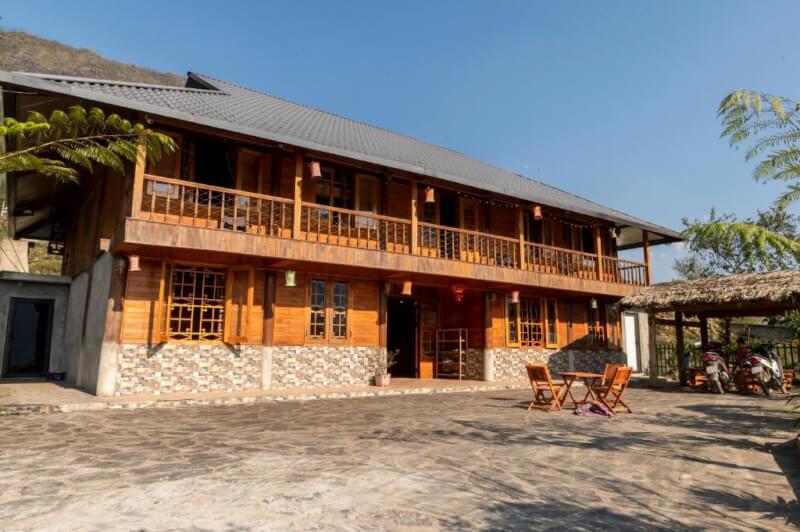
Viettrekking Homestay Sapa
- Address: End of Hoang Lien Son Street
- Reference Price: Approximately 350,000 – 550,000 VND/night (private room)
- Features: Nicknamed the "House on the Clouds" due to its location on a high hill, it boasts an incredible view for cloud hunting over Mường Hoa Valley and Fansipan Peak. It is very popular with young travelers for its many photogenic "check-in" spots.
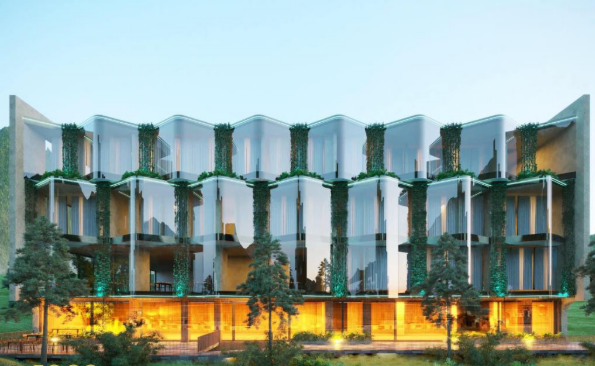
Budget and Mid-Range Stays
Hello Mu Cang Chai Homestay
- Address: La Pan Tan, Mu Cang Chai.
- Reference Price: Approximately 150,000 VND/person/night (Dorm) or 600,000 – 700,000 VND/room/night (Bungalow).
Mu Cang Chai Ecolodge
- Address: Nam Khat Commune, Mu Cang Chai.
- Reference Price: Approximately 600,000 – 1,200,000 VND/night.
Tram Tau Hot Spring Homestay (Homestay Suoi Khoang Nong Tram Tau)
- Address: Area 5, Tram Tau Commune (near Nghia Lo).
- Reference Price: Approximately 100,000 VND/person/night (Communal Stilt House) or 400,000 VND/private room/night.
Local Cuisine and Festival Culture
High-End Restaurant
Tung Duong Place
Tung Duong Place is one of the reputable establishments providing restaurant services in the Lao Cai Ward area. It currently owns a chain of services, including a Northwest specialty restaurant, a luxurious conference and event center-one of the finest in Lao Cai-and a farm for raising and cultivating organic food. This is one of the few facilities whose restaurant system, guest rooms, and accompanying services meet recommended standards.
The Tung Duong Place Restaurant and Conference/Event Center is built on nearly 1 hectare of land located in the central area. The restaurant area has a total area of nearly 1,000m², including a stilt house section built in the traditional style of the Black Thai ethnic group, and a landscaped garden with a small fish pond, creating an intimate, cozy, and peaceful feeling for diners.
- Address: 37 Quang Trung Street, Group 51, Yen Bai Ward.
- Contact: 094 488 38 94
- Email: [email protected]
- Hours of Operation: 8:00 AM - 9:21 PM
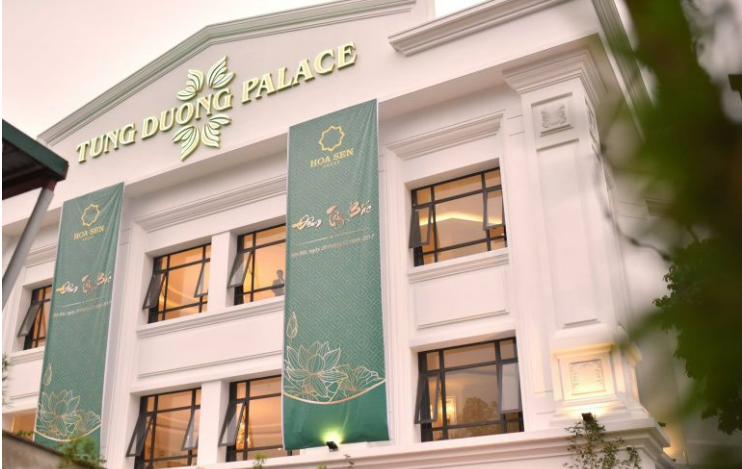
Hong Long Restaurant
Hong Long Restaurant is a renowned dining establishment in Lao Cai City. It specializes in supplying and serving specialties related to sturgeon and salmon. After more than a decade of establishment and development, Hong Long has made a beautiful impression on both local residents and tourists from all over the country. Guided by the principle, "Customer satisfaction is paramount," Hong Long Restaurant has continuously innovated, developed, and dedicated itself to customer service. Hong Long has completely rebuilt its premises, which span an area of 3,000m². It features many VIP rooms, conference rooms, and private dining areas with a total capacity of up to 600 people simultaneously. Therefore, many people seek out the restaurant for hosting guests, organizing parties, and holding banquets.
- Address: An Duong Vuong Street (Red River Embankment) - Lao Cai Ward
- Phone: 098 924 95 89
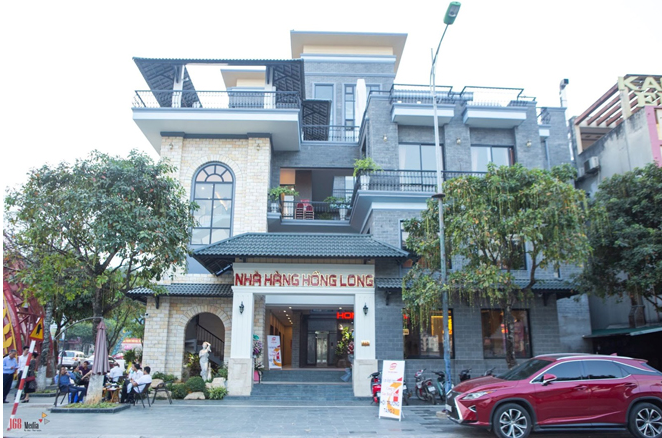
Culinary Exploration Experience
Unlike the cuisine of other regions, the cuisine of Lao Cai is deeply rooted in the Northwest mountains and forests, featuring rustic, unique dishes tied to the culture of ethnic minorities like the H'Mong, Dao, and Thai.
Tourists should visit the Sa Pa Night Market to enjoy grilled foods (grilled eggs, grilled skewered meat, grilled corn) and local eateries in the villages of Ta Van and Lao Chai to try ethnic dishes such as bamboo-tube rice, five-colored sticky rice, and interact with the local residents. Salmon and sturgeon are farmed in Sa Pa's cold water conditions, resulting in firm, flavorful meat. The fish hotpot is served with fresh wild vegetables, making it a warming dish for travelers amidst the misty weather.
-
Armpit Pork (often called Local Village Pig) is a famous specialty of Lao Cai, prepared from pigs naturally raised on the hillsides. The meat is firm, the skin is crispy, and the flavor is naturally sweet. The dish is typically grilled or roasted until the skin is crispy, and is served with a characteristic spicy dipping sauce of the H'Mông people, rich with the flavors of the Northwest mountains. Visitors can enjoy this dish at the Bac Ha Weekend Market, the Sa Pa culinary area (Sa Pa Ward, Fansipan Road), or A Quynh Restaurant (15 Thach Son, Sa Pa).
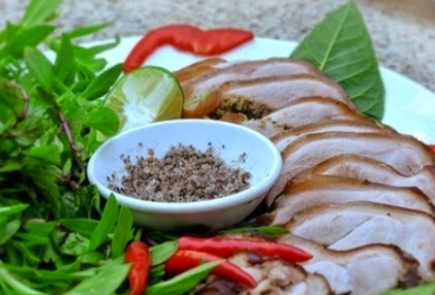
- Horse Meat Stew is a traditional dish of the H'Mông people, prepared from horse meat and internal organs along with many characteristic highland spices. Although its flavor can be polarizing, it is an indispensable dish at highland weekend markets and represents the strongest culinary experience for visitors to Lao Cai. Tourists can enjoy Thang Co at the Bac Ha Weekend Market, the Sa Pa culinary area, or ethnic specialty restaurants on Fansipan Street and Cau May Street (Sa Pa Ward).
-
Meo Cabbage and Chayote are specialty vegetables grown on the high mountains of Sa Pa. They are always fresh, crunchy, and naturally sweet, and are usually prepared simply—boiled or stir-fried with garlic—to preserve their natural flavor. You can enjoy these rustic vegetable dishes at local eateries, A Quynh Restaurant (15 Thach Son, Sa Pa), or Hai Lam Restaurant (72 Xuan Vien, Sa Pa)—places renowned for their highland cuisine.
Exploring culinary experiences:
Coming to Lao Cai, go to restaurants along Highway 32 or Homestays on stilts in Mu Cang Chai to enjoy a traditional Thai meal. In particular, you should try local sticky rice wine or apple cider to complete the highland flavor.
-
Tu Le Rice and Five Sac Sticky Rice: Tu Le Sticky Rice is famous for its special fragrant sticky rice. The five-color sticky rice dish (made from natural leaf colors) of Thai people in Tu Le is not only delicious but also beautiful.

- Gac Bep Buffalo Meat: Is a famous specialty Thai language in Mu Cang Chai and Tram Tau. Buffalo meat is marinated with mac khen, doi seeds, lemongrass, and ginger, then smoked in the kitchen to dry and give off a characteristic aroma. The dish has a rich, mildly spicy taste, is often served with corn wine, and is a gift that many tourists buy. You can find it at Mu Cang Chai market or Nghia Lo specialty stores.
- Grilled Stream Fish: Fresh fish are caught from the stream in Tram Tau, Mu Cang Chai, then marinated with forest spices and grilled on the grill. embers, creating a fragrant fish dish with sweet, not fishy meat. This is a familiar dish in Thai meals, visitors can enjoy it at Thai Nghia Lo village restaurants or Mu Cang Chai highland homestays.
- Sat Shoots, Stream Moss are typical products of the mountains and forests of Lao Cai, people collect and process into many rustic dishes such as boiled bamboo shoots dipped in salt and chili, grilled moss or moss cooked in soup. Visitors can enjoy these delicious fresh wild vegetable dishes at homestays in Ta Van and Ta Phin villages (Sa Pa) or ethnic restaurants in Sa Pa culinary area.
Cultural experience
Bac Ha Fair
Bac Ha market is highly appreciated in the country and throughout Southeast Asia. The market opens once a week on Sunday morning, located 70km from Lao Cai City and right in Bac Ha commune. Although it has gone through a very long period of formation and development, this place still retains its extremely rare characteristics, converging from ethnic groups such as Mong, Tay, Nung, Dao, Phu La... The market is divided into many areas such as: brocade area, vegetable and fruit area, food area, ornamental plant area... Of which the area with the largest proportion is the area selling agricultural products of local people. In particular, visitors to Bac Ha market can also enjoy many delicious highland specialties such as: thang co, Bac Ha sour pho, corn dumplings...

Xen Muong Festival of Thai Muong Lo people
The Xen Muong Festival of Thai Muong Lo people is usually held during the season of white ban flowers blooming in the mountains and forests, which is around January or February of the lunar calendar. This festival takes place in the Nghia Lo Museum Branch area to commemorate the gods who enlightened Muong, and at the same time pray for prosperity and happiness for Thai people. The Xen Muong Festival will be organized by Mr. Mo Nghe, who oversees the authority of the Muong owner and the Association of Elders. This festival takes the shirts of commune leaders as sacrifices, offerings will be contributed by the people of the entire Muong.
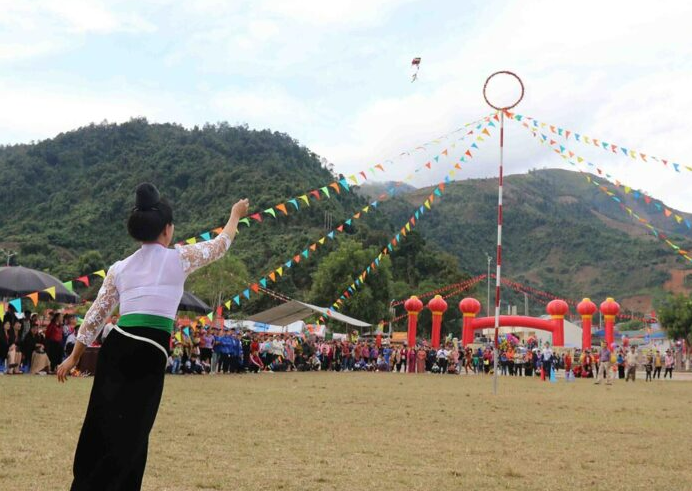
In addition, visitors to Lao Cai also have the opportunity to immerse themselves in the vibrant atmosphere of many unique traditional cultural festivals.
- Gau Tao Festival of the H'Mong people to pray for good fortune at the beginning of the year.
- Roong Pooc Festival of the Giay people in Ta Van.
- Thuong Temple Festival commemorating Saint Tran,.
- Down to the Field Festival opens the harvest season new.
- Bac Ha Festival with traditional horse racing also attracts many tourists.
Amusement area
Funny Kids entertainment area: Is the point Come and go once, you will want to experience it again and again, parents. This is an educational play area for children from 0 - 13 years old located right on the 1st floor of GO! So it's always convenient for the whole family to eat and shop together.

>
Sun World Fansipan Legend (Sa Pa):Amusement area The biggest and most prominent location in Lao Cai is Sun World Fansipan Legend, located in Sa Pa commune. This is a high-class tourism, cultural, religious, and entertainment complex, considered "Paradise on the roof of Indochina".
- Scale and Experience: This area not only has the world-record Fansipan Cable Car, helps visitors conquer Fansipan Peak - "Roof of Indochina" easily, but also includes diverse experiences.
- Main activities: Visitors can take the train to climb Muong Hoa mountain, worship the Spiritual Cultural Complex with the Great Buddha A Statue. Amitabha and Bich Van Thien Tu, check-in at the National Flagpole, and enjoy unique indigenous cultural festivals and shows throughout the four seasons.

Sun World Fansipan Legend
Aeris Hill (Tu Le)
Located in Tu Le, this is Outstanding adventure experience area, providing many thrilling games for young people and those who love to exercise. The highlight is the longest Zipline in Vietnam, the first Zorbing game (rolling in a giant ball) in Vietnam, along with High rope and climbing areas.

Suggested tours
Continued information News for Lao Cai travel guide are some suggestions for outstanding tours here, specifically:
Experience tour
Sapa 2D1D Tour (Departing from Hanoi): Hanoi - Explore Sapa
- Itinerary: Hanoi → Sapa → Cat Cat Village →Explore Ham Rong or Fansipan → Return to Hanoi
- Transportation: Car
- Reference tour price: 2,518,000/person VND
- Organizer: SST Travel / Ms. USA: 0707 260 119
Quang Binh Lao Cai Sapa Tour “Cat Cat – Ham Rong – 4D3N
- Day 1: Quang Binh → Hanoi → Lao Cai
- Day 2: Lao Cai → Sapa → Cat Cat Village
- Day 3: Sapa – Ham Rong → Lao Cai → Hanoi Noi
- Day 4: Hanoi → Quang Binh
Transportation:
- Main means of transport: train and car, suitable for journeys between routes.
- SE / SP trains are used for long distance sections (Quang Binh ↔ Hanoi ↔ Laos Cai).
- Cars used in the sections Lao Cai ↔ Sapa ↔ attractions.
Price: 1,490,000 VND
Organizer: Hung Viet Trading & Tourism Services Co., Ltd.
Phone: +84 2323 818 878 (Office) and Hotline +84 918 805 368
Shopping and Souvenirs
Lao Cai is not only famous for its majestic scenery but also has many specialties and handicraft products imbued with highland identity for visitors to choose as gifts after the trip. In Lao Cai, visitors can buy Sa Pa brocade handwoven by the H'Mong, Dao, Tay people with delicate patterns, bright colors, suitable for making scarves, bags or decorations. In addition, wild honey, apple wine, shiitake mushrooms, dried bamboo shoots, and meat Stove buffaloes are famous specialties often sold at Sa Pa market, Bac Ha market or Lao Cai city center.

Brocade in Lao Cai
Or typical gifts including Shan Tuyet Suoi Giang tea - a type of ancient tea famous for its pure aroma and green rice flakes. Tu Le, Muong Lo sticky rice or Tu Le sticky wine are all specialties loved by many people. Tourists can buy them at Nghia Lo market, Mu Cang Chai or local craft production facilities.
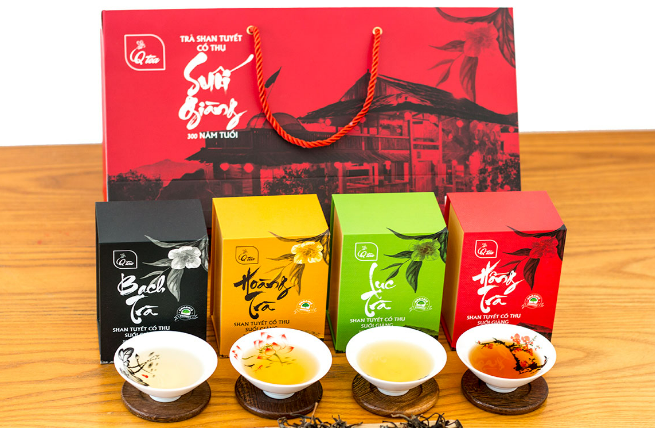
Shan Tuyet Suoi Tea Giang
Each gift carries the flavor and spirit of the Northwest mountains and forests - simple but rich, a great way to preserve memories after the journey to explore Lao Cai.
Notes and Essential Information for Traveling to Lào Cai
Support and Other Key Information
-
Lao Cai Provincial Police: Headquarters located at 506 Dien Bien Street, Yen Bai Ward, Lao Cai City. Contact phone number is 069.2506.112 and Email: [email protected].
-
Lao Cai Provincial Department of Tourism: This agency is headquartered at the Provincial Public Administration Service Center Building, Tran Hung Dao Avenue, Nam Cuong Ward, Lao Cai City. Tourists can contact them via phone at (0214) 3800 201 or Email: [email protected]. The official website is sodulich.laocai.gov.vn.
-
Consumer Protection Agency (Lao Cai Department of Industry and Trade): The agency managing consumer rights protection is headquartered at Block 7, Tran Hung Dao Avenue, Nam Cuong Ward, Lao Cai City. The hotline is 02143820173 and the contact email is [email protected].
-
In case of emergency, you can quickly contact the following hotlines: 113 (Police), 114 (Fire Department), 115 (Medical Emergency)...
Congratulations! You are now fully equipped with the knowledge from this Northwest travel manual!
